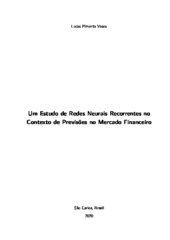| dc.contributor.author | Vasco, Lucas Pimenta | |
| dc.date.accessioned | 2021-01-20T21:30:15Z | |
| dc.date.available | 2021-01-20T21:30:15Z | |
| dc.date.issued | 2020-12-17 | |
| dc.identifier.citation | VASCO, Lucas Pimenta. Um estudo de redes neurais recorrentes no contexto de previsões no mercado financeiro. 2020. Trabalho de Conclusão de Curso (Graduação em Engenharia de Computação) – Universidade Federal de São Carlos, São Carlos, 2020. Disponível em: https://repositorio.ufscar.br/handle/ufscar/13730. | * |
| dc.identifier.uri | https://repositorio.ufscar.br/handle/ufscar/13730 | |
| dc.description.abstract | Financial time series forecasting is one of the most researched artificial intelligence applications by financial market analysts, both in the academic and corporate world. Within this area, there is a great emphasis on the prediction of stock values, mainly due to the possibility of profitability. One of the most used techniques to make this type of prediction is the application of artificial neural networks.
This work is focused on one of the classes of artificial neural networks, the recurrent neural networks. Three types of architecture in this area are used: the Vanilla Recurrent Neural Network (VRNN) model, the Long Short-Term Memory (LSTM) model and the Gated Recurrent Unit (GRU) model. Throughout this paper, models of each of these architectures are created for three different stocks of the Brazilian stock exchange, namely the stocks from Grupo Fleury (FLRY3), Petrobras (PETR4) and Vale (VALE3). The models created for each of the stocks make a prediction of the value of those stocks, and the results are compared to each other with the intention of evaluating which model predicts the values closest to the real values. The accuracy measures used in this work are the mean absolute error and the mean square error. In the end, it was concluded that the GRU and LSTM models obtain similar results, with a slightly better performance from GRU, and VRNN was able to detect patterns in the data, but not as accurately as the other two. | por |
| dc.description.sponsorship | Não recebi financiamento | por |
| dc.language.iso | por | por |
| dc.publisher | Universidade Federal de São Carlos | por |
| dc.rights | Attribution-NonCommercial-NoDerivs 3.0 Brazil | * |
| dc.rights.uri | http://creativecommons.org/licenses/by-nc-nd/3.0/br/ | * |
| dc.subject | Predição de ações | por |
| dc.subject | Redes Neurais Artificiais | por |
| dc.subject | Redes Neurais Recorrentes | por |
| dc.subject | Stock Prediction | por |
| dc.subject | Artificial Neural Networks | por |
| dc.subject | Recurrent Neural Networks | por |
| dc.title | Um estudo de redes neurais recorrentes no contexto de previsões no mercado financeiro | por |
| dc.title.alternative | A study on recurrent neural networks in the context of financial market predictions | por |
| dc.type | TCC | por |
| dc.contributor.advisor1 | Camargo, Heloisa de Arruda | |
| dc.contributor.advisor1Lattes | http://lattes.cnpq.br/0487231065057783 | por |
| dc.description.resumo | Predição de séries temporais financeiras é uma das aplicações de inteligência artificial mais estudadas por pesquisadores do mercado financeiro, tanto no mundo acadêmico quanto no corporativo. Dentro dessa área, há um grande destaque para a predição de valores de ações, principalmente devido à possibilidade de rentabilidade. Uma das técnicas mais utilizadas para fazer esse tipo de predição é a aplicação de redes neurais artificiais.
Esse trabalho é focado em uma das classes de redes neurais artificiais, as redes neurais recorrentes. São utilizados três tipos de arquitetura dessa área: o modelo de redes neurais recorrentes simples (VRNN, do inglês Vanilla Recurrent Neural Network), o Long Short-Term Memory (LSTM) e o Gated Recurrent Unit (GRU). Ao longo do trabalho são criados modelos de cada uma dessas arquiteturas para três ações diferentes da bolsa de valores brasileira, mais especificamente das ações do Grupo Fleury (FLRY3), da Petrobras (PETR4) e da Vale (VALE3). Os modelos criados para cada uma das ações fazem uma predição dos valores dessas ações, e os resultados são comparados entre si com a intenção de avaliar qual predição obtém os valores mais próximos dos valores reais. As medidas de erro utilizadas nesse trabalho são o erro absoluto médio e o erro quadrático médio. Ao final, concluiu-se que os modelos GRU e LSTM obtém resultados semelhantes, com um desempenho um pouco melhor do GRU, e o VRNN conseguiu detectar padrões nos dados, mas não com tanta precisão quantos os outros. | por |
| dc.publisher.initials | UFSCar | por |
| dc.subject.cnpq | CIENCIAS EXATAS E DA TERRA::CIENCIA DA COMPUTACAO::METODOLOGIA E TECNICAS DA COMPUTACAO | por |
| dc.publisher.address | Câmpus São Carlos | por |
| dc.contributor.authorlattes | http://lattes.cnpq.br/4304143156783753 | por |
| dc.publisher.course | Engenharia de Computação - EC | por |

